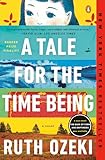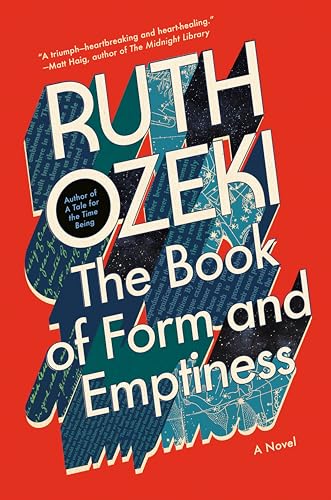For several months after Ruth Ozeki’s father died in 1998, she began hearing his voice calling her name. She’d be typing or folding the laundry, and she’d turn to look for him. He wasn’t there. “It was startling whenever it happened,” she recalls, “and also comforting.” It was painful, as well.
“I’d remember he was dead and feel a rush of sadness, like I was losing him again,” says Ozeki, 65, speaking over Zoom from her home in Northampton, Mass.
This haunting experience offered the germ of the idea for Ozeki’s fourth novel, The Book of Form and Emptiness—out in late September from Viking. It follows Benny, a mixed-race teenager who begins to hear voices after his Japanese father dies. At first he hears the voice of his dead father. Then he begins to hear the emotions of material objects—a table leg, a pair of scissors. Then he begins hearing from a book, which helps narrate this heartbreaking coming-of-age story.
The novel is told through a captivating conversation in itself. Benny talks to the book in some chapters; in others, the book talks back to him, often offering advice to a young man muddling through his teenage years.
“I can’t think of many other writers who are such magical storytellers,” says Paul Slovak, an executive editor at Viking, who read an early draft of The Book of Form and Emptiness two years ago. (Ozeki sold it on a six-page proposal in 2015.) Slovak, who edited the novel, is particularly impressed by its structure. “I love working with writers who want to find new ways of telling stories,” he says, adding that this book is “somehow playful and deeply serious.”
 Playful and serious are two words that also describe Ozeki herself. She often speaks of her work in a lighthearted way. “Books don’t come to me quickly,” she jokes, referring to the eight-year gap since she published her widely beloved third novel, A Tale for the Time Being, another bildungsroman. It was a finalist for the Man Booker Prize and the National Book Critics Circle Award.
Playful and serious are two words that also describe Ozeki herself. She often speaks of her work in a lighthearted way. “Books don’t come to me quickly,” she jokes, referring to the eight-year gap since she published her widely beloved third novel, A Tale for the Time Being, another bildungsroman. It was a finalist for the Man Booker Prize and the National Book Critics Circle Award.
According to Slovak, A Tale for the Time Being has sold more than 300,000 copies. It’s also been praised as “exquisite” (the Los Angeles Times), “intellectually provocative” (the Washington Post), and “masterfully woven” (O, the Oprah Magazine). It centers on a 16-year-old Japanese girl who plans to kill herself after being bullied, but before she does so, she begins to document her great grandmother’s life.
“It touched a nerve with young readers,” Slovak says, adding that it’s been chosen by many colleges as suggested reading for freshmen.
The tour for A Tale for the Time Being also inspired aspects of The Book of Form and Emptiness. At an Ann Arbor, Mich., book signing, Ozeki found herself explaining to an audience that her stories often come to her in voices. Characters talk to her in her head, and a book slowly forms. Unexpectedly, a man stood and shared that his son also heard voices but found it distressing rather than welcome. This led Ozeki to consider the intersection between what we identify as madness and creativity. She remembered this man and his son as she began to craft Benny and research the phenomenon of hearing voices.
Ozeki already knew writers often heard people talking in their minds; some authors go so far as reporting entire conversations they have with those they’re writing about. She believes it makes for the magic of dialogue, and it’s something she experiences regularly. “There’s always a whole cast of characters carrying on inside my head,” she says, her cheery meditative spirit evident as she sits in her sunny, sparsely decorated home office. She’s also a Zen Buddhist priest and radiates calm in conversation.
Some discoveries in Ozeki’s research fascinated her. She discovered that, though hearing voices is often pathologized as a form of schizophrenia, it’s also an experience that’s been reported by such historical figures as Joan of Arc, Freud, and Gandhi. “The more I learned about voice hearing,” Ozeki says, “the more I realized how many people hear voices but are never diagnosed with anything.” This, she adds, gave her a desire to “widen our appreciation of neurodiversity.”
But in the novel, Benny doesn’t see anything magical about his situation. He’s deeply disturbed by it, sometimes slamming his palms over his ears to make the voices around him stop. If objects have feelings, Ozeki shows us, they’re not always happy ones.
For Benny, the voices become too much, and at one point in the novel he winds up institutionalized. This painful (yet entertaining) section was inspired by Ozeki’s own experience living in a psychiatric ward after she developed severe anxiety at boarding school as a teenager. “It was like finding myself in a prison,” she says of those years.
After he’s released, Benny takes refuge from the voices by spending hours, sometimes entire days, in the public library. This, also, was inspired by Ozeki’s own biography. She spent hours in the library as a child and then worked in her college library. She recalls time spent deep in the stacks, stringing together book titles into “found poetry” and sketching out characters for future novels. “I don’t think I was a very efficient worker,” she says with a laugh. And yet, libraries have always been a “place of powerful magic” for her.
Carole DeSanti, Ozeki’s longtime editor who left Viking before she finished her draft of The Book of Form and Emptiness, says she’s watched Ozeki grow with each novel she’s published, noting that the biggest leap came with her last one. Still, it’s her originality that continues to draw readers to her work. “Her voice is lively and immediate, funny, global, and radical,” DeSanti says.
Ozeki began her storytelling career as a filmmaker. After working on a string of B movies and Japanese commercials in the 1980s, she maxed out two credit cards to finance her own movies in the ’90s—one of which, the documentary Halving the Bones, went to Sundance.
She credits those years with helping her learn how to keep a plot moving. “It’s like my mind is a camera, and when I write a scene, I’m visualizing the angle of the shot, and the framing, and the movement,” she says. “Is it a wide establishing shot, or an extreme close-up? Is the camera tracking the action, or are the shots locked off and static?”

 Feeling overwhelmed with her struggling finances as a filmmaker, Ozeki began writing a novel, hoping the sale of the book would help her pay her way out of credit card debt. It wound up launching a new career. Her debut, My Year of Meats, was published by Viking in 1998; it follows a Japanese American documentary filmmaker hired by the American beef lobby to make promotional TV shows for the Japanese market. In 2003 Viking released All Over Creation, a story about a teenage runaway returning home as an adult to her estranged parents.
Feeling overwhelmed with her struggling finances as a filmmaker, Ozeki began writing a novel, hoping the sale of the book would help her pay her way out of credit card debt. It wound up launching a new career. Her debut, My Year of Meats, was published by Viking in 1998; it follows a Japanese American documentary filmmaker hired by the American beef lobby to make promotional TV shows for the Japanese market. In 2003 Viking released All Over Creation, a story about a teenage runaway returning home as an adult to her estranged parents.
When asked her why many of her characters seem to exist on the periphery of society, Ozeki doesn’t hesitate. “It’s directly reflective of my experience growing up,” she says. She’s the daughter of a white father and Japanese mother, and she explains that when she was young, a Japanese girl could be pretty and polite, good at math and music, but not loud or obnoxious or rebellious. When she lived in Japan after college, she realized she was entitled to be all of those things—similar to the way her character, Benny, begins to accept all of the different sides of himself, even the voice hearing.
According to Ozeki, her life has always been lived on the margins. “But the margins can be a wonderful place,” she says. “The view is always better from the outside.”
This piece was produced in partnership with Publishers Weekly.










